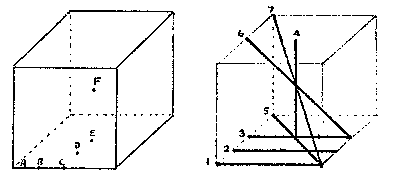|
Cell class |
Example |
Number of cells in class |
Number of lines through cell |
|
A |
(0,0,0) |
16 |
7 |
|
B |
(0,0,1) |
48 |
4 |
|
C |
(0,0,2) |
24 |
4 |
|
D |
(0,1,2) |
24 |
3 |
|
E |
(0,2,2) |
12 |
5 |
|
F |
(2,2,2) |
1 |
13 |
 (Original
image as drowned by R. Schroeppel)
(Original
image as drowned by R. Schroeppel)
|
Line class |
Endpoints of example |
Number of lines in class |
Average equation (see below) |
|
1 |
(0,0,0)-(0,0,4) |
24 |
2a + 2b + c = K |
|
2 |
(0,1,0)-(0,1,4) |
24 |
4b + d = K |
|
3 |
(0,2,0)-(0,2,4) |
24 |
2c + 2d + e = K |
|
4 |
(2,2,0)-(2,2,4) |
3 |
4e + f = K |
|
5 |
(0,0,0)-(0,4,4) |
24 |
2a + 2b + e = K |
|
6 |
(2,0,0)-(2,4,4) |
6 |
4c + f = K |
|
7 |
(0,0,0)-(4,4,4) |
4 |
4a + f = K |